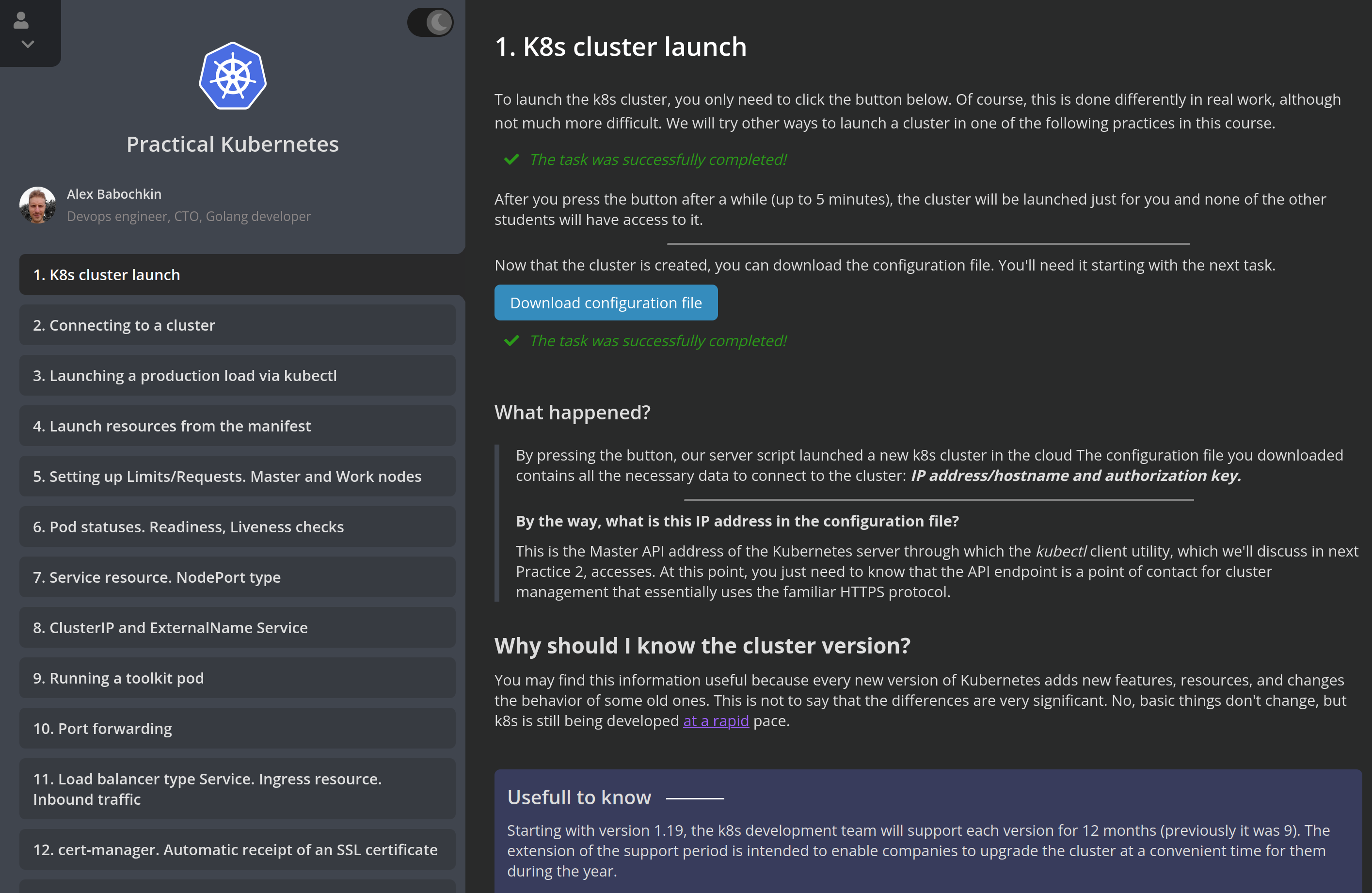Kubernetes
Practical kubernetes
The course is suitable not only for DevOps engineers, but also for developers, dealing with k8s. It includes all the important practical knowledge, necessary for work. The course is based on an approach “from practice to theory” - you won’t be bored!
Practice objectives (25 lessons)
- Starting a cluster, configuration file
- Installing kubectl. Connecting to the cluster
- Launching a production load via kubectl
- Creating a manifest to describe the load (pod, deployment)
- Setting up Limits/Requests. Master and Work nodes
- Pod status. Readiness, Liveness checks
- Service resource. Type NodePort
- Service of type ClusterIP and ExternalName
- Launching a pod with tools (ping, dig, telnet...)
- Port forwarding
- Service of type Load balancer. Ingress resource. Passing traffic from the Internet
- Cert-manager. Automatically obtain an SSL certificate
- Data storage: ConfigMap, Secrets
- Volumes: data persistence (PV, PVC)
- Config Volumes: connect ConfigMap files
- Setting up the application via ENV and Secrets
- StatefulSets
- DaemonSet
- Jobs and scheduled launch Cronjobs
- NodeAffinity, NodeSelector
- PodDisruptionBudget, PriorityClass
- Scaling pods: HorizontalPodAutoscaler
- Scaling nodes: Autoscaler
- LimitRange/ResourceQuota
- Service Accounts & RBAC
Let's launch the cluster, connect to it, find out what connection methods there are and choose the most convenient one
Next, run a test load and figure out exactly how containers are launched in a Pod
After that, you will learn how to create manifests describing Kubernetes resources, and also explore all the most popular resources that are required in daily work
Let's look at how the load is distributed across the k8s cluster, what types of nodes exist, and how we can limit the consumption of individual applications to ensure reliable operation of the entire cluster
Dive into the network part: services, port-forwarding, ingress. Let's launch the load balancer and cert-manager to issue a real SSL certificate.
Notice the difference between stateful/stateless services. Let's connect volumes to store application data and their configuration (configmap/secrets)
Learn how to run scheduled tasks via cronjobs, as well as select the node on which to run the application.
Learn more about scaling both pods and the nodes themselves in order to dynamically change resources and withstand the load
And of course, we will study how it is possible to strengthen the security of applications and the entire cluster through service accounts and Role Based Access Control
What do I get after completing the course?
- Ability to run applications on a Kubernetes cluster
- Understanding limitations and how to overcome them
- Ability to operate all basic resources in k8s
- Ability to solve a full range of problems to ensure the availability of applications from the Internet
- Ability to scale applications depending on load
- Understanding how statefull/stateless applications work
Who is this course for?
For devops engineers, developers and other IT specialists, who somehow deal with Kubernetes. Currently the level the adoption of this product is very high among various organizations and understanding the intricacies of its work are often required.
How does automatic job verification work?
Depending on the task, a special algorithm inspects the resources of your Kubernetes cluster and compares your work with the required result
What basic training do I need to complete the assignments?
You will need confident terminal (console) skills and basic knowledge of working with client-server applications
How long is this course for?
The estimated time to complete this course is 20-30 hours. There are no class schedules, you learn at a pace that suits you and always pick up where you left off.
If I haven't found the answer to my question, can you help?
Sure! If something is not clear at any step, then ask. If there is no information at all, ask too. Perhaps we will add a new section.
Can I skip some tasks and go straight to the free one?
Yes you can. However, it should be taken into account that some tasks depend on one or more previous ones. In this case, you need to complete them first. For example, you cannot run something in a cluster if you have not completed the first step (launching the cluster itself)
How it works
/01
You receive detailed instructions and theory for completing each task and a ready-made test stand
/02
After completing the task, your result is automatically checked
/03
For each course assignment, you can ask a question to the author and receive an answer. It is important to us that everything is clear to you
Mentorship Programm (4-6 months)
Personalized approach
During the first one-on-one online meeting, we will determine your goals and skills. We will then create a professional growth plan tailored to you.
Practical learning
You are moving according to plan, including using our courses.
Regular meetings
The program includes 4 personal consultations during which we will definitely address all questions.
Real project work
After mastering the course materials, you can move on to a project that has a real-world counterpart in production and operates on the same codebase. At this stage, the previously acquired knowledge will be reinforced. You will be provided with the source code, instructions, and support.
Unique learning materials
Only within the training program you will have access to materials, including a selection of real DevOps cases, problems, and solutions.
A sense of confidence
After successfully completing the program, you will be confident in your abilities and the new practical skills you have acquired.
Own platform
The platform designed for effective learning includes a convenient web interface

There is a light skin

Platform
benefits
Team
Reviews
Blog
Early bird access
Be among the first to receive an invitation and a special price
Thanks
We will contact you as soon as the course is ready
Need help?
Ask a question
We will answer faster than you think
Thanks for reaching out
You will receive an answer soon


